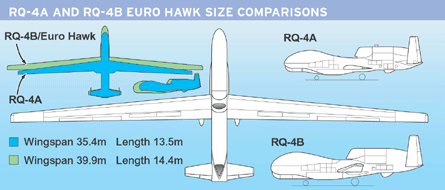The US federal government's expenditure investigation body is calling for the suspension of serial production of the Northrop Grumman RQ-4B Global Hawk unmanned air vehicle and for the programme to be massively reviewed.
A report by the US Government Accountability Office (formerly General Accounting Office, GAO) says manufacture of the RQ-4B should be limited only to flight test articles, pending maturation of proposed signals intelligence and imaging radar payloads which may require extensive air vehicle modifications.
The GAO is also calling for the US Air Force’s business case for RQ-4B production to be updated, including creation of better cost estimates for the system on the back of what it says is a 73% increase in acquisition and procurement unit costs since development of the variant commenced in 2001.
The recommendation come ahead of the finalisation of a high level re-baselining of the RQ-4B programme by the USAF in response to a congressional review last April. That review was triggered by the programme breaching unit procurement cost plans by 18%.
The USAF rejects the latest GAO findings, arguing that if implemented, this would "stop the established production line, incurring significant cost and schedule delays. Combatant commanders continue to request this capability, and the acquisition strategy balances risk with the need to support the warfighter."
The GAO report reveals that while Northrop Grumman began production of the first RQ-4Bs in July 2004, differences between the larger variant and the existing RQ-4A aircraft (pictured below) have proven to be "more extensive, complex and costly than anticipated. Within a year, there were more than 2,000 authorised engineering changes to the total baseline of 1,400 drawings, and more than half were considered major changes.
"Also, once manufacturing began, there were recurring quality and performance issues on the work of several key subcontractors. The subcontractor building the tail scrapped seven of the first eight main structural components because of design changes and manufacturing process deficiencies".

Source: Flight International























